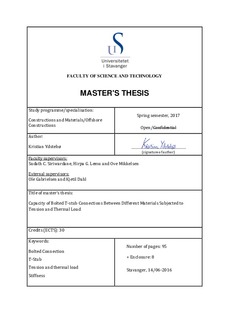| dc.contributor.advisor | C. Siriwardane, Sudath | |
| dc.contributor.advisor | G. Lemu, Hirpa | |
| dc.contributor.advisor | Mikkelsen, Ove | |
| dc.contributor.advisor | Gabrielsen, Ole | |
| dc.contributor.advisor | Dahl, Kjetil | |
| dc.contributor.author | Ydstebø, Kristian | |
| dc.date.accessioned | 2017-10-20T06:55:48Z | |
| dc.date.available | 2017-10-20T06:55:48Z | |
| dc.date.issued | 2017-06-14 | |
| dc.identifier.uri | http://hdl.handle.net/11250/2461150 | |
| dc.description | Master's thesis in Offshore structural engineering | nb_NO |
| dc.description.abstract | The purpose of this thesis is to study the behaviour of bolted T-stub connections of different materials subjected to tension and thermal load. In the Eurocode, NS-EN 1993-1-8 [1], there are given rules and guidelines for determining the stiffness and capacity of a T-stub connection.
In this thesis, the theoretical capacity from the Eurocode is compared to both an experimental and numerical investigation. It is emphasised to study the connections real behaviour and thoroughly investigate how well a T-stub connection can be estimated with the Eurocode and a finite element (FE) model.
In the experimental investigation, a total of six tensile tests of the T-stub connections connected by two bolts has been performed. The tests were divided into two configurations, a steel – steel connection and an aluminium – steel connection. It has also been performed numerical analysis of the same geometries in the finite element software, Abaqus. The numerical analysis is, together with the theoretical calculations from the Eurocode, compared with the experimental results. It was found that the result from the Eurocode is conservative and do not identify the failure mode achieved in the tensile tests for both configurations. The stiffness was also overestimated. The FE model was a good approximation to the real behaviour and capacity of the tensile tests.
It was also established an FE model of the connections subjected to thermal load, where temperature increased from the range of -20 – 200 °C. The connections were preloaded before adding the thermal load. It was found that with all the components of steel, preload force maintained the same throughout the load. The connection with both aluminium and steel components, the preload force increased due to the different rate of expansion of the materials. | nb_NO |
| dc.language.iso | eng | nb_NO |
| dc.publisher | University of Stavanger, Norway | nb_NO |
| dc.relation.ispartofseries | Masteroppgave/UIS-TN-IKM/2017; | |
| dc.rights | Navngivelse 4.0 Internasjonal | * |
| dc.rights.uri | http://creativecommons.org/licenses/by/4.0/deed.no | * |
| dc.subject | offshore teknologi | nb_NO |
| dc.subject | konstruksjonsteknikk | nb_NO |
| dc.subject | T-stub | nb_NO |
| dc.subject | bolted connection | nb_NO |
| dc.subject | stiffness | nb_NO |
| dc.subject | tension | nb_NO |
| dc.subject | thermal load | nb_NO |
| dc.title | Capacity of Bolted T-stub Connections Between Different Materials Subjected to Tension and Thermal Load | nb_NO |
| dc.type | Master thesis | nb_NO |
| dc.subject.nsi | VDP::Teknologi: 500::Bygningsfag: 530::Konstruksjonsteknologi: 533 | nb_NO |

